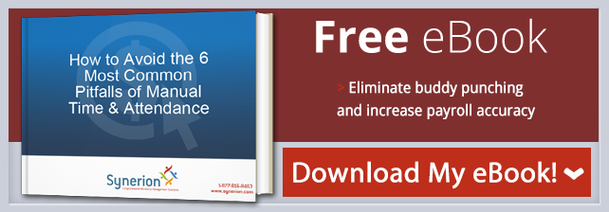Synerion Blog
The Cost of Absenteeism in the Workplace

Absenteeism is an inevitability in any industry. Employees become ill, have personal emergencies, and need vacations to relax and recuperate. Still, the cost of absenteeism can be a steep one when it's not controlled. Unscheduled absences cost US employers conservatively $3,600 annually for hourly employees and $2,650 annually for salaried employees, and costs don't stop there.
Beyond the Loss of Productivity
It's easy to focus on the initial loss of productivity caused by absenteeism but it stretches far beyond that loss. The cost of absenteeism also includes a loss of productivity and increase in exhaustion for remaining employees. In cases of absenteeism, employers are forced to rely on other employees working overtime or calling in less skilled workers who can't complete the job as effectively as full time employees. This increases the time it takes to adequately complete jobs and calls on other employees to step outside their normal duties to make up the difference.
Frequent absenteeism also has serious ramifications on morale. Employees become exhausted, which can lead to safety issues and a higher risk of illness which leads to more unscheduled absences. Frequent absenteeism causes frustration among employees. Remaining employees are resentful of being burdened with extra work and less employees to perform it. This can increase employee turnover and add stress to the workplace.
Absenteeism Isn't Just Missed Shifts
Employers also need to look at partial shift absences when calculating the price of absenteeism in the workplace. Partial shift absences consist of times where employees arrive late, leave early, and take longer breaks than scheduled into their day. Partial shift loss has been shown to cause a 0.72% increase in payroll inflation.
While the occasional long lunch or late morning may not affect productivity, continued abuses decrease productivity and morale. Employees who see their coworkers leaving the job early or taking a long lunch feel that they're entitled to that additional time off too. Employers need to consider the cost of absenteeism in all its forms to control payroll costs.
How to Control Absenteeism
While employers can't eliminate absenteeism, they can take steps to control it. Investing in time tracking devices to allow management and employees to have an accurate understanding of what paid time off (PTO) is available to the employee. Employees are also held accountable for partial shift absences when time tracking devices are used.
Accountability and rewards are other low-tech ways to control the cost of absenteeism in the workplace. HR and management need to team up to ensure that every department understands their PTO policy and have the authority to hold employees accountable to that policy. Employees who regularly take unscheduled absences or are regularly logging partial shift absences should be subject to a disciplinary process that addresses and corrects those absences. On the other end of the spectrum, employees who regularly conform to the PTO policy should be rewarded.
Addressing the underlying causes of absenteeism can also help improve absenteeism rates. Morale plays a large part in absenteeism. Companies with high morale had one-third less absenteeism than organizations that had low or poor morale. Employees also site bullying as a reason for absenteeism. By focusing on employee morale, employers can decrease the cost of absenteeism.
While absenteeism is inevitable, it can also be controlled. Absenteeism needs to be restricted to true emergencies and pre-planned time off, not late lunches and unneeded "sick" days. When organizations understand the underlying costs beyond overtime and overstaffing, they can start addressing this waste of resources and decrease in morale. Through time tracking and accountability, organizations can reign in those excessive costs.

